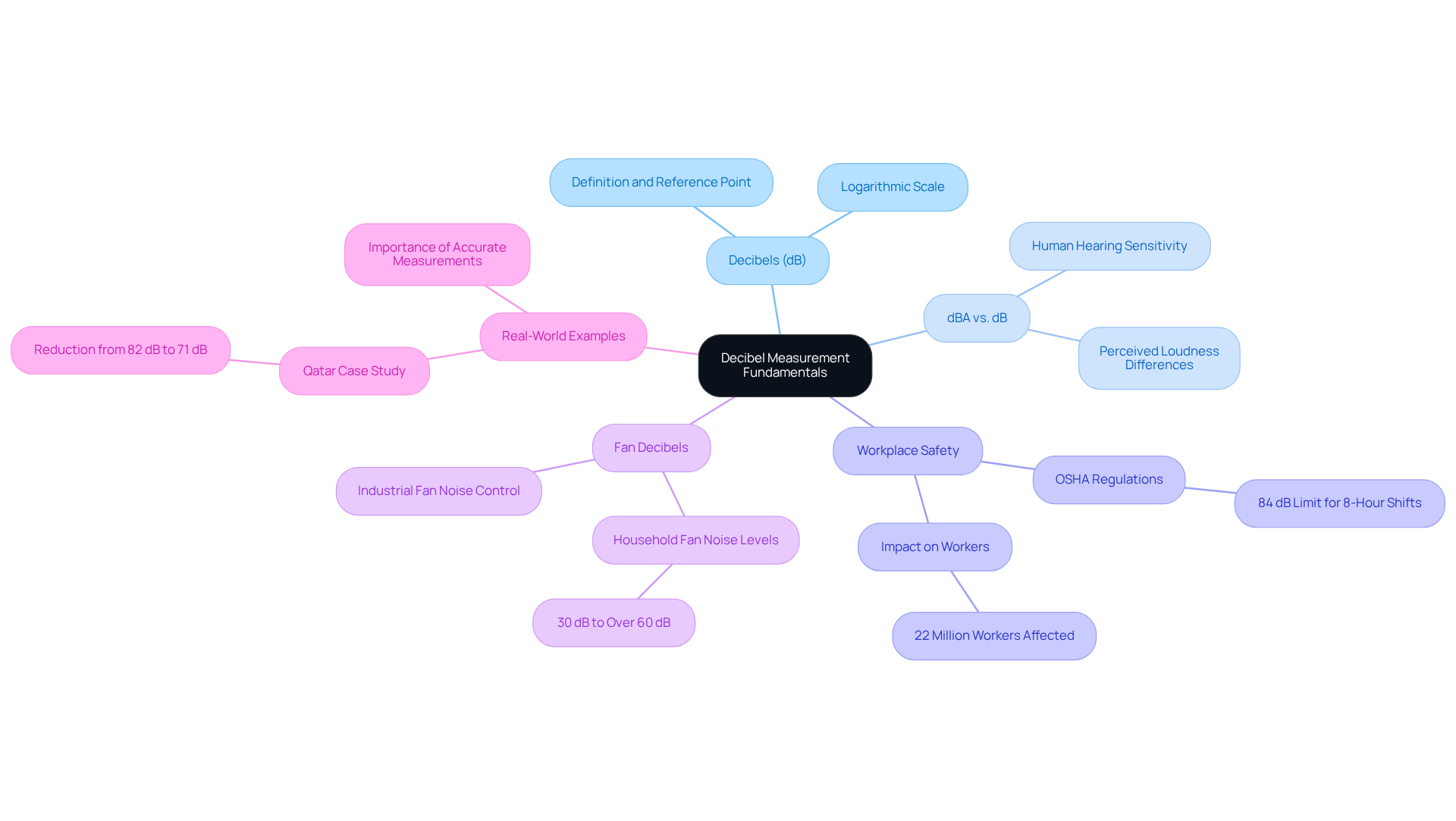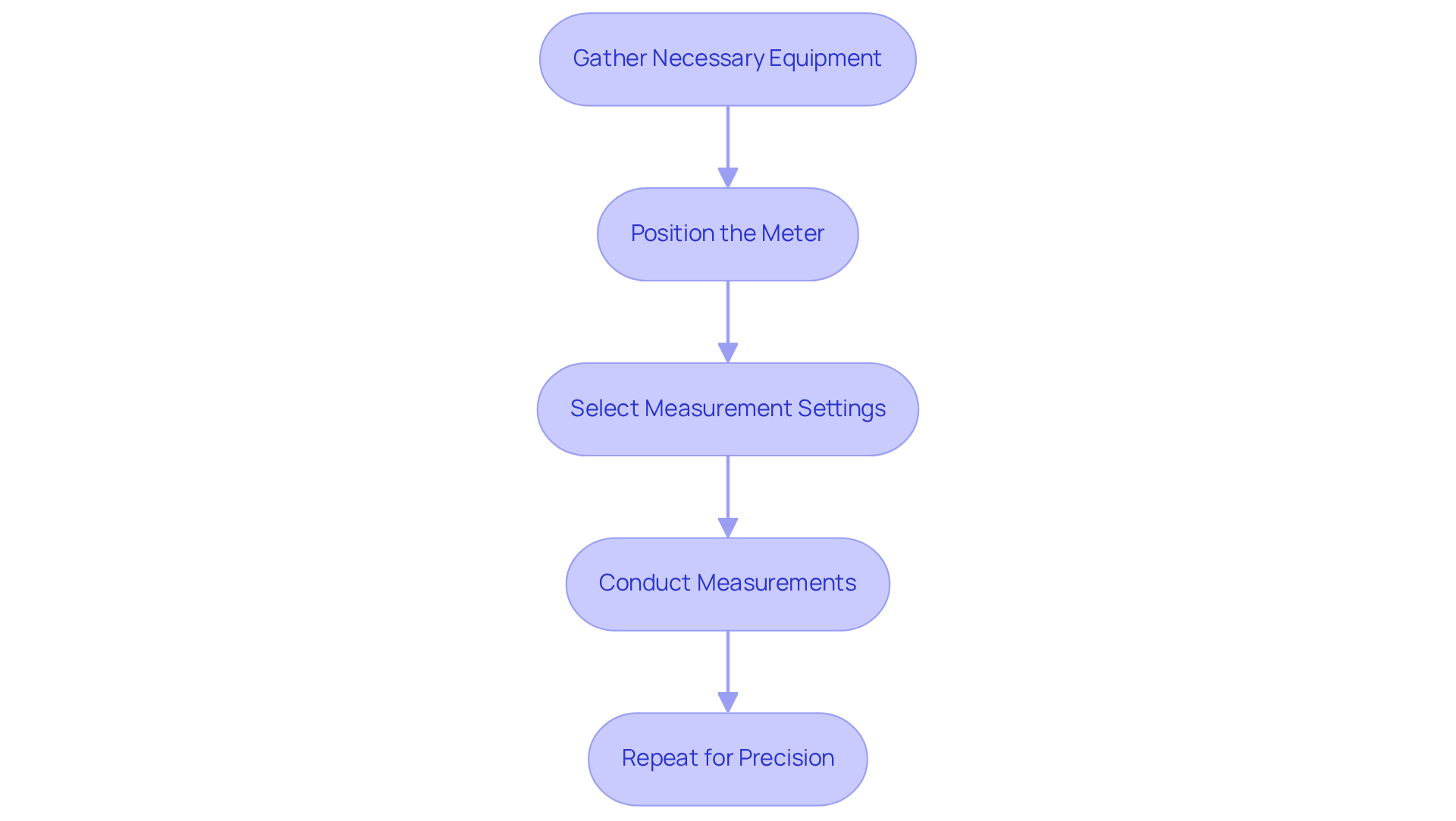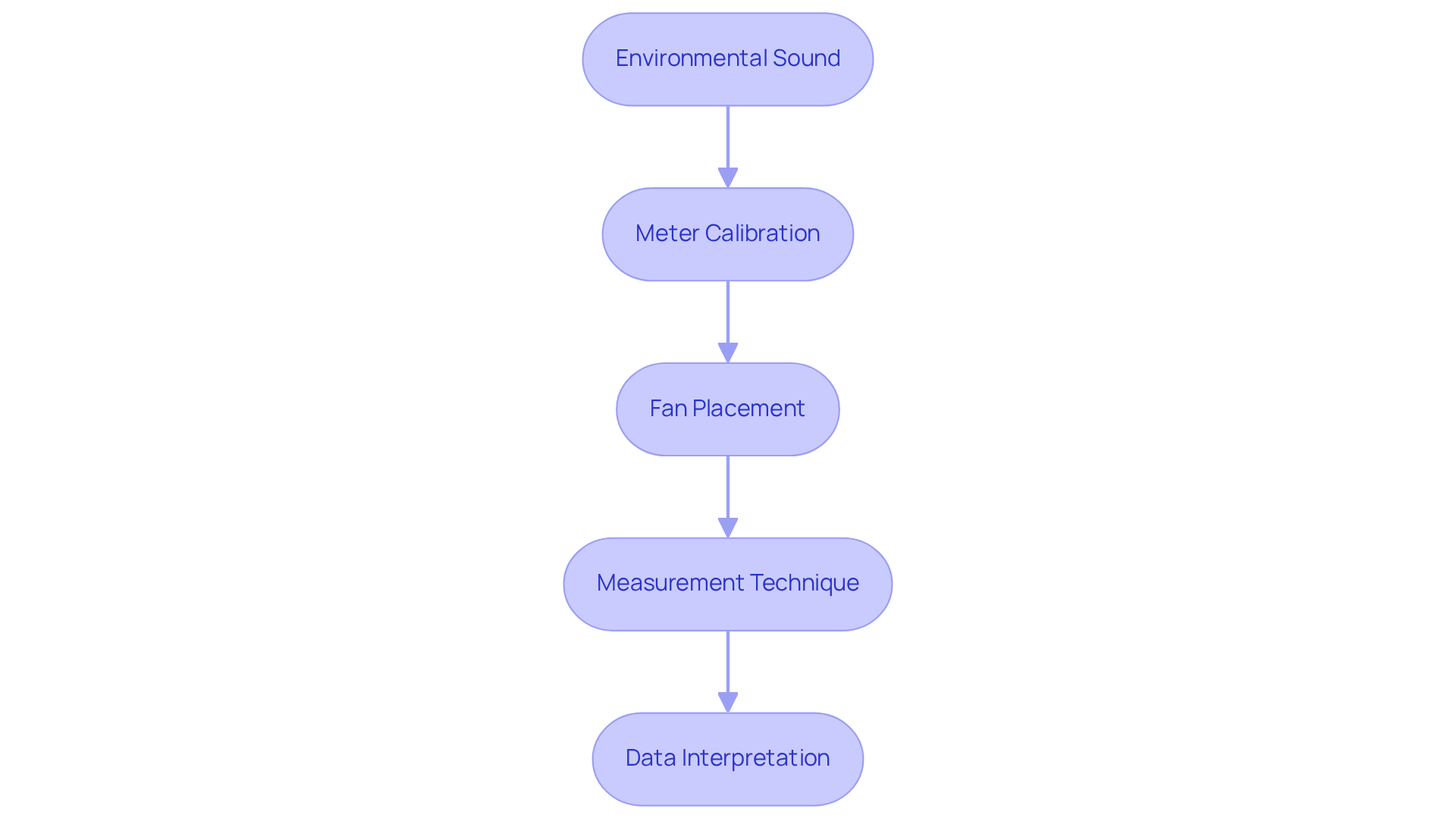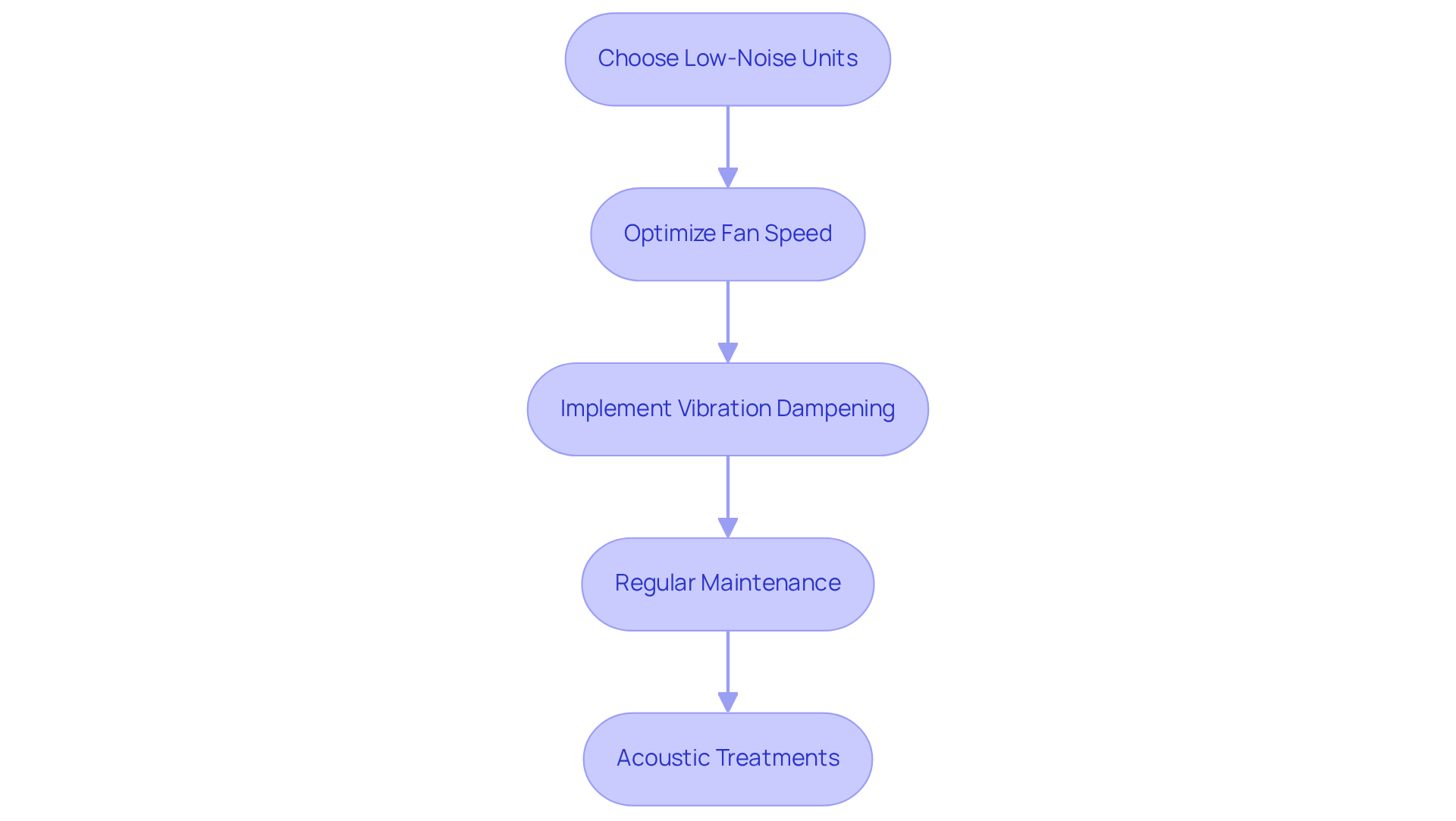Introduction
Understanding the complexities of decibel measurement is essential in an environment where noise pollution can profoundly affect health and productivity. This article explores the fundamentals of measuring fan noise, providing readers with critical insights into effective troubleshooting and noise reduction strategies. As workplaces increasingly emphasize sound control, individuals must ensure they accurately assess and manage fan decibel levels to protect their environments.
Noise pollution poses a significant challenge, impacting not only individual well-being but also overall workplace efficiency. By delving into the intricacies of decibel measurement, we can better understand how to mitigate these effects. This exploration will equip you with the knowledge needed to tackle noise issues head-on, fostering a more conducive work atmosphere.
Clarify Decibel Measurement Fundamentals
Decibels (dB) serve as a logarithmic unit for measuring auditory intensity, establishing a relative scale that compares acoustic intensities to a reference point, typically the threshold of hearing (0 dB). Understanding the distinction between dB and dBA (A-weighted decibels) is essential, as dBA accounts for human hearing sensitivity, emphasizing frequencies that are more perceptible. For instance, a noise level of 60 dBA is perceived as significantly louder than one at 50 dBA, despite the 10 dB difference. This distinction is particularly important in contexts such as workplace safety, where the Occupational Safety and Health Administration (OSHA) mandates that noise intensity remains at or below 84 dB for an 8-hour shift to protect hearing. Alarmingly, approximately 22 million workers encounter potentially harmful auditory disturbances in the workplace each year, underscoring the importance of accurate measurements.
Grasping fan decibels and acoustic pressure ratings (SPL) is also vital for effective evaluations of fan disturbances. Average pressure readings for various fan types can differ markedly; for example, household fans may produce fan decibels ranging from 30 dB for quieter models to over 60 dB for high-speed settings. In industrial settings, implementing effective noise control strategies can significantly reduce exposure to harmful auditory intensities. Utilizing level meters with a range of 40 to 130 dB, ensuring precise calibration, and following recommended measurement procedures are critical for obtaining reliable results.
Real-world examples further illustrate the necessity of accurate intensity measurement. A case study conducted in Qatar showcased successful reduction measures that decreased warehouse fan decibels from 82 dB to 71 dB, highlighting the effectiveness of proper assessment techniques. The strategies employed included regular calibration of audio measurement devices and meticulous documentation of metrics and observations to track changes and ensure data integrity. By adopting these methods, engineers can achieve dependable measurements that inform effective noise control strategies.

Outline Step-by-Step Measurement Procedures
-
Gather Necessary Equipment: To begin, ensure you have a calibrated audio measurement device that meets IEC 61672 standards. A tripod or stand is also recommended for stability. Remember, frequent calibration of audio meters is essential for preserving measurement precision.
-
Position the Meter: Next, position the noise measuring device at a height of approximately 1 meter from the ground, facing the fan directly. It’s crucial to keep it at least 1 meter away from any walls to avoid reflections that could skew your results. Keep in mind that pressure intensity decreases by -6 dB when the distance from the source doubles, which is vital for understanding how distance impacts your measurements.
-
Select Measurement Settings: Set the meter to A-weighting (dBA) to accurately reflect human hearing sensitivity. Opt for the ‘slow’ response setting to achieve more stable readings.
-
Conduct Measurements: Turn on the fan and allow it to reach its operating speed. Document the audio intensity at various distances (1m, 2m, etc.) to understand how sound diminishes with distance. Typically, household fans generate noise measurements known as fan decibels, ranging from 30 dB for quieter models to over 60 dB for high-speed settings, providing context for your assessments.
-
Repeat for Precision: To ensure accuracy, take several readings at each distance and average them to account for any variations in sound intensity. Document all findings for thorough analysis. For instance, a case study revealed that noise reduction measures decreased the intensity of warehouse fan decibels from 82 dB to 71 dB, illustrating the effectiveness of appropriate evaluation and management strategies. Furthermore, NIOSH recommends limiting 8-hour exposure to less than 85 dBA, underscoring the importance of accurate measurements for health and safety.

Identify and Troubleshoot Measurement Challenges
-
Environmental Sound: Background sounds can significantly interfere with measurements. To ensure accuracy, conduct measurements in a quiet environment or during off-peak hours, minimizing potential interference.
-
Meter Calibration: It is crucial to ensure that the sound intensity meter is calibrated before use. Regular calibration checks are necessary to maintain accuracy and reliability in your measurements.
-
Fan Placement: The location of the fan can greatly influence sound intensity. Ensure it is mounted securely and not vibrating against any surfaces, as this can amplify noise and skew results.
-
Measurement Technique: Avoid moving the meter during measurement. Any movement can lead to fluctuations in readings. Utilize a tripod to stabilize the meter, ensuring consistent and accurate measurements.
-
Data Interpretation: It is essential to understand that decibel levels are logarithmic. A small increase in dB can represent a significant increase in perceived loudness. Exercise caution when comparing measurements to avoid misinterpretation.

Implement Strategies to Minimize Fan Noise
-
Choose Low-Noise Units: Select devices specifically designed for quiet operation, focusing on models with dBA ratings as low as 10-20 dBA. Gagner-Toomey Associates offers a range of low-noise ventilation devices optimized for performance and efficiency, making them ideal for environments where sound control is crucial, such as home theaters and libraries.
-
Optimize Fan Speed: Implement variable speed controls to adjust fan speeds based on cooling demands. This approach not only enhances performance but also minimizes disturbances during periods of low activity, as Gagner-Toomey’s DC input units operate efficiently at lower RPMs.
-
Implement Vibration Dampening: Use rubber mounts or pads to isolate blowers from the chassis. This technique significantly reduces vibration transfer, a common source of noise, ensuring quieter operation, especially for the high-performance units and blowers in Gagner-Toomey’s extensive product range.
-
Regular Maintenance: Maintain fans by keeping them clean and free from dust buildup, which can lead to imbalances and increased noise levels. Regular lubrication of moving components is essential for smooth operation and sound reduction, particularly for Gagner-Toomey’s custom and standard cooling solutions.
-
Acoustic Treatments: Improve noise control by integrating sound-absorbing materials around the fan area. Enclosures or acoustic panels can effectively dampen sound transmission, complementing the low-noise design of Gagner-Toomey’s innovative cooling products. Additionally, consider the IP protection options available in many models to ensure durability across various environments.

Conclusion
Understanding and managing fan decibels is crucial for workplace safety and comfort across various environments. By mastering the measurement of noise levels, individuals can effectively identify sources of disturbances and implement strategies to mitigate them. This article has provided a comprehensive overview of the fundamentals of decibel measurement, practical step-by-step procedures, and effective noise reduction techniques.
Key insights include:
- The importance of distinguishing between dB and dBA
- The necessity of accurate measurement tools and techniques
- The significant impact of environmental factors on sound intensity readings
Real-world examples highlight the effectiveness of systematic approaches to reduce noise levels, demonstrating that with the right methods, it is possible to achieve a quieter and more conducive atmosphere.
Ultimately, the significance of measuring and managing fan noise cannot be overstated. Whether for enhancing workplace safety or improving the comfort of living and working spaces, taking proactive steps to understand and control fan decibels is essential. By applying the techniques and strategies outlined in this article, individuals can ensure compliance with safety regulations and create a more pleasant auditory environment.
Frequently Asked Questions
What are decibels (dB) and how are they measured?
Decibels (dB) are a logarithmic unit for measuring auditory intensity, establishing a relative scale that compares acoustic intensities to a reference point, typically the threshold of hearing (0 dB).
What is the difference between dB and dBA?
dBA (A-weighted decibels) accounts for human hearing sensitivity, emphasizing frequencies that are more perceptible. For example, a noise level of 60 dBA is perceived as significantly louder than one at 50 dBA, despite the 10 dB difference.
Why is understanding dBA important in workplace safety?
Understanding dBA is crucial in workplace safety because the Occupational Safety and Health Administration (OSHA) mandates that noise intensity remains at or below 84 dB for an 8-hour shift to protect hearing.
How many workers are affected by potentially harmful auditory disturbances in the workplace?
Approximately 22 million workers encounter potentially harmful auditory disturbances in the workplace each year.
What are the typical decibel levels for household and industrial fans?
Household fans may produce noise levels ranging from 30 dB for quieter models to over 60 dB for high-speed settings. Industrial fans can also produce varying decibel levels, necessitating effective noise control strategies.
What tools are essential for measuring decibel levels accurately?
Level meters with a range of 40 to 130 dB are essential for measuring decibel levels accurately. It is important to ensure precise calibration and follow recommended measurement procedures.
Can you provide an example of successful noise reduction in a real-world scenario?
A case study conducted in Qatar demonstrated successful noise reduction measures that decreased warehouse fan decibels from 82 dB to 71 dB. This was achieved through regular calibration of audio measurement devices and meticulous documentation of metrics and observations.
What strategies can engineers use to achieve dependable measurements for noise control?
Engineers can achieve dependable measurements by adopting methods such as regular calibration of audio measurement devices, meticulous documentation of metrics and observations, and following effective assessment techniques to track changes and ensure data integrity.

